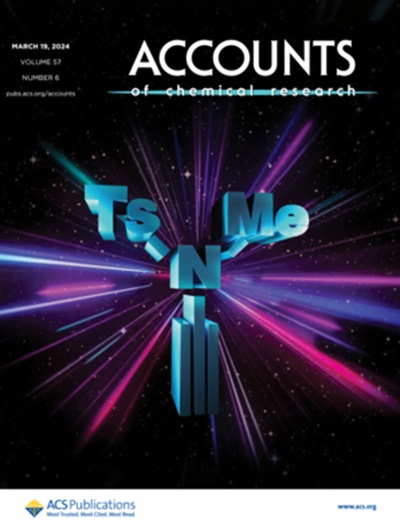不对称有机金属电化学合成(AOES)研究进展。
摘要
近年来,课程组在电化学与不对称过渡金属催化相结合的不对称有机金属电化学合成(AOES)领域进行了大量的研究。一方面,有机金属化合物可以作为分子电催化剂(介质),降低过电位,提高反应活性和选择性。另一方面,通过电化学可以大大改善过渡金属催化不对称的条件,通过控制电化学电位和调节电流的电子传递速率来精确调节过渡金属的氧化态。这种协同方法解决了传统不对称过渡金属催化固有的关键挑战,特别是与氧化还原活性化学试剂的使用有关的挑战。此外,分子电催化剂的氧化还原电位可以通过修饰其配体来调节,从而控制反应的区域选择性和立体选择性。因此,AOES已成为一种强大而有前途的手性化合物合成工具。在这篇文章中,我们总结了近年来我们在AOES领域的努力。我们的主要策略是利用电化学电位和电流的可控性来调节有机金属的氧化状态,从而促进所需的反应。在温和条件下建立了高效的不对称合成平台,显著降低了对化学氧化还原试剂的依赖。我们的研究基于不同的电解模式系统地分为三个部分:不对称过渡金属催化结合阳极氧化,阴极还原和配对电解。在每个部分中,我们将重点介绍针对各自电解模式的独特特征而量身定制的创新发现。在许多转化过程中,过渡金属催化的传统化学氧化还原试剂和电化学反应表现出相似的反应活性。然而,在某些情况下,我们也观察到显著的差异。(1)提高了不对称电化学合成的效率:例如,铑催化的C-H键的对映选择性电化学功能化表现出优异的效率。(2)扩大了转化的范围:由于氧化还原电位的可调性,以前在传统过渡金属催化中具有挑战性的某些转化可以通过电化学来实现。一个显著的例子是芳酰氯的对映选择性还原偶联,它显著地扩大了可达转化的范围。此外,我们的机理研究探索了电化学固有的独特技术,如控制电位电解实验,电极材料对催化剂性能的影响,以及循环伏安法研究。这些研究通过对电化学机理的研究,对金属催化剂的行为有了更直观的认识,也可以指导新的催化体系的设计。这一领域的进步为环境友好和可持续的选择性不对称转换提供了一个强大的平台。通过将电化学与过渡金属催化相结合,我们开发了一种通用的有机合成方法,不仅提高了反应的效率和选择性,而且减少了对环境的影响。我们预计,该账户将刺激AOES领域的进一步研究和创新,从而发现新的催化体系和发展更可持续的合成方法。ConspectusIn recent years, our research group has dedicated significant effort to the field of asymmetric organometallic electrochemical synthesis (AOES), which integrates electrochemistry with asymmetric transition metal catalysis. On one hand, we have rationalized that organometallic compounds can serve as molecular electrocatalysts (mediators) to reduce overpotentials and enhance both the reactivity and selectivity of reactions. On the other hand, the conditions for asymmetric transition metal catalysis can be substantially improved through electrochemistry, enabling precise modulation of the transition metal's oxidation state by controlling electrochemical potentials and regulating the electron transfer rate via current adjustments. This synergistic approach addresses key challenges inherent in traditional asymmetric transition metal catalysis, particularly those related to the use of redox-active chemical reagents. Furthermore, the redox potentials of molecular electrocatalysts can be conveniently tuned by modifying their ligands, thereby governing the reaction regioselectivity and stereoselectivity. As a result, the AOES has emerged as a powerful and promising tool for the synthesis of chiral compounds.In this Account, we summarize and contextualize our recent efforts in the field of AOES. Our primary strategy involves leveraging the controllability of electrochemical potential and current to regulate the oxidation state of organometallics, thereby facilitating the desired reactions. An efficient asymmetric synthesis platform was established under mild conditions, significantly reducing the reliance on chemical redox reagents. Our research has been systematically categorized into three sections based on distinct electrolysis modes: asymmetric transition metal catalysis combined with anodic oxidation, cathodic reduction, and paired electrolysis. In each section, we highlight our innovative discoveries tailored to the unique characteristics of the respective electrolysis modes.In many transformations, transition metal-catalyzed reactions involving traditional chemical redox reagents and those utilizing electrochemistry exhibit similar reactivities. However, we also observed notable differences in certain cases. These findings include the following: (1) Enhanced efficiency in asymmetric electrochemical synthesis: for instance, the Rh-catalyzed enantioselective electrochemical functionalization of C-H bonds demonstrates superior efficiency. (2) Expanded scope of transformations: certain transformations, previously challenging in traditional transition metal catalysis, can be achieved through electrochemistry due to the tunability of redox potentials. A notable example is the enantioselective reductive coupling of aryl chlorides, which significantly expands the range of accessible transformations. Additionally, our mechanistic studies explore unique techniques intrinsic to electrochemistry, such as controlled potential electrolysis experiments, the impact of electrode materials on catalyst performance, and cyclic voltammetry studies. These investigations provide a more intuitive understanding of the behavior of metal catalysts through the study of electrochemical mechanisms, which can also guide the design of new catalytic systems.The advancements in this field offer a robust platform for environmentally friendly and sustainable selective asymmetric transformations. By integrating electrochemistry with transition metal catalysis, we have developed a versatile approach for organic synthesis that not only enhances the efficiency and selectivity of reactions but also reduces the environmental impact. We anticipate that this Account will stimulate further research and innovation in the realm of AOES, leading to the discovery of new catalytic systems and the development of more sustainable synthetic methodologies.

 求助内容:
求助内容: 应助结果提醒方式:
应助结果提醒方式:


